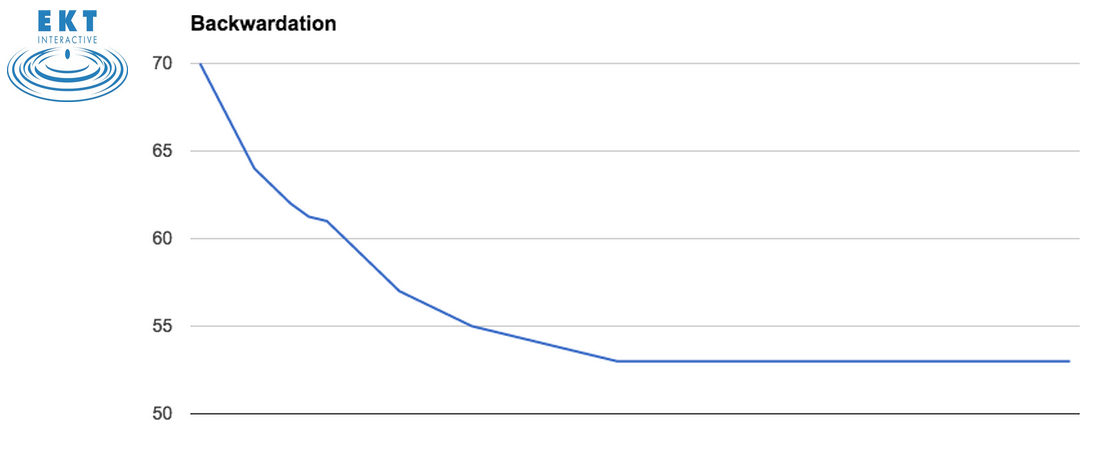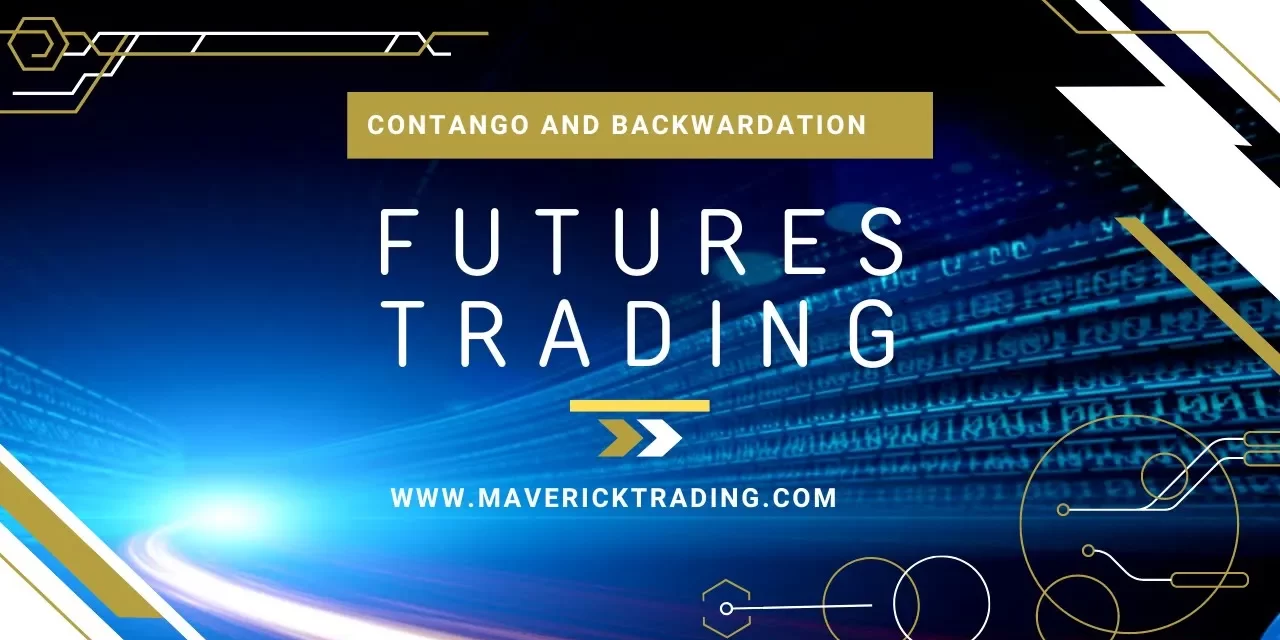Mastering Futures Trading: Understanding Contango and Backwardation for Smarter Strategies
In the fast-paced world of futures trading, where market volatility can turn opportunities into profits or pitfalls overnight, grasping key concepts like contango and backwardation is essential. These terms might sound like jargon from a Wall Street thriller, but they’re the backbone of how futures prices behave compared to spot prices. Whether you’re a novice trader dipping your toes into commodity markets or a seasoned pro refining your options trading strategies, understanding these dynamics can sharpen your edge.

Alt text: Contango and backwardation futures curve chart illustrating forward price evolution in contango (decreasing) and backwardation (increasing) over time for futures trading strategies.
At Maverick Trading, we’re committed to empowering traders with actionable knowledge through our free resources. That’s why we’re spotlighting our exclusive video, “Futures Trading: Contango and Backwardation”, available right here in our free video section. This concise yet powerful tutorial breaks down these concepts with real-world examples, helping you navigate the futures curve like a pro. Watch it now to see how these market states influence everything from oil contracts to agricultural commodities.

In this in-depth article, we delve deeper into the video’s insights, exploring what contango and backwardation mean, why they occur, and how you can leverage them in your futures trading strategies. By the end, you’ll have a roadmap to spot these patterns early and integrate them into your portfolio. Let’s roll up our sleeves and get into the nitty-gritty—because in trading, knowledge isn’t just power; it’s profit.
What Is Contango? The Normal State of Futures Markets
Picture this: You’re eyeing crude oil futures, and the contract for delivery three months from now is priced higher than today’s spot price. That’s contango in action—a situation where futures prices exceed the current spot price, creating an upward-sloping futures curve.
As explained in our Maverick Trading video, contango is the “normal” or default state for many futures markets. Why? It accounts for the cost of carry—the expenses involved in holding the underlying asset until delivery. Think storage fees for oil in tanks, insurance for grains in silos, or even interest on the capital tied up. These costs push future prices up, incentivizing traders to store and deliver later.

Alt text: Crude oil futures in contango show a sloping curve for futures trading, with prices increasing over contract months.
For instance, in a stable market like gold, contango might add 1-2% per month to reflect financing costs. But when does it become a red flag? In prolonged contango, like during the 2020 oil glut, futures prices skyrocketed relative to spot, leading to negative oil prices in extreme cases. Our video highlights how this erodes roll yields for long positions—when you roll over expiring contracts, you’re essentially selling low and buying high, chipping away at returns.
SEO tip for traders: If you’re searching for “contango in futures trading,” remember it’s not always bad. It signals ample supply and low immediate demand, perfect for short-selling strategies if you’re bearish on the asset.
Decoding Backwardation: When Futures Flip the Script
Flip the script, and you get backwardation—the intriguing counterpart where futures prices dip below the spot price, forming a downward-sloping curve. This “abnormal” state screams urgency: Demand is outstripping supply right now, so buyers are willing to pay a premium for immediate delivery over future promises.
Our futures trading video uses vivid examples, like during supply disruptions in natural gas markets. Imagine a harsh winter spiking heating demand—spot prices soar, but futures settle lower as traders bet on normalized supply later. Backwardation often arises from temporary shocks: geopolitical tensions in oil-producing regions, crop failures in agriculture, or even pandemics disrupting logistics.

Alt text: Backwardation in commodity futures trading (e.g., oil or natural gas) with a downward sloping curve, showing a spot premium over future contracts.
Quantitatively, backwardation boosts roll yields for long traders. Rolling contracts means buying cheaper futures, amplifying gains if the market converges back to spot. Historical data from the CME Group shows backwardation in copper during 2021’s supply chain snarls, where front-month contracts traded 5-10% above later ones, rewarding patient bulls.
For options traders at Maverick Trading, this is gold. Backwardation enhances strategies like calendar spreads, where you sell near-term options (high premium) and buy longer-dated ones (cheaper). It’s a volatility play that aligns perfectly with our community-taught approaches.
Causes of Contango and Backwardation: Supply, Demand, and Human Psychology
So, what triggers these shifts? Our video demystifies this with a trader’s lens, emphasizing that contango and backwardation aren’t random—they’re symptoms of broader market forces.
Contango thrives in oversupplied environments. Abundant harvests flood grain markets, or OPEC ramps up oil production, depressing spot prices while futures bake in storage costs. Interest rates play a role, too; higher rates widen contango by increasing the cost of carry. Psychologically, it’s complacency: Traders expect equilibrium, so they price in predictability.
Conversely, backwardation erupts from scarcity. Wars, strikes, or weather events create “fear premiums” for spot goods. In 2022’s energy crisis, European natural gas futures plunged into deep backwardation as Russia-Ukraine tensions choked pipelines. Storage limitations exacerbate this—there’s only so much you can hoard before it spoils or overflows.
Maverick Trading’s tutorial stresses monitoring the futures curve via platforms like TradingView or CME tools. Look for the spread between front-month and back-month contracts: Positive and widening? Contango. Negative and steepening? Backwardation. Pair this with fundamentals—USDA reports for ag, EIA data for energy—and you’ve got a predictive edge.
Trading Strategies: Turning Contango and Backwardation into Profits
Knowledge without action is trivia, right? The real value in our video lies in its practical takeaways for futures trading strategies. Here’s how to operationalize these concepts:
1. Roll Yield Arbitrage in Contango
In contango-heavy markets like WTI crude, avoid naive long rolls. Instead, go short the front month and long the back month (a “contango spread” trade). This captures the convergence as prices normalize, pocketing the carry cost differential. Risk management is key—use stops at 2x the average true range (ATR) to dodge black swans.
2. Momentum Plays in Backwardation
Backwardation is a bull’s playground. Enter long positions in front-month contracts, riding the spot premium until the curve flattens. Enhance with options: Buy calls on ETFs like USO (oil) during backwardation spikes. Our Maverick pros often layer in VIX futures analysis, as backwardation correlates with volatility surges—perfect for strangles.

Alt text: Futures trading strategies infographic comparing contango (cash-and-carry arbitrage) and backwardation (reverse cash-and-carry) with examples and risks.
3. Hedging Across Market States
Commodity producers love backwardation for locking in high spot-equivalent prices via futures. Consumers, conversely, hedge in contango to secure lower future costs. Diversify with pairs: Long corn in backwardation (drought fears) versus short soybeans in contango (bumper crop).
Backtested data from 2015-2023 shows backwardation strategies outperforming by 15-20% annually in energy sectors, per QuantConnect simulations. But beware slippage and commissions—they eat into thin margins.
At Maverick Trading, our free video ties this to real charts, showing a 2022 nat gas trade that netted 25% in weeks. Join our community for live sessions where we dissect these setups weekly.
Risks and Common Pitfalls in Futures Curve Trading
No strategy’s foolproof, and our video doesn’t sugarcoat it. Contango can trap “storage arbitrage” plays if unexpected demand surges, flipping the curve. Backwardation, meanwhile, risks snap reversals—think 2020’s oil crash ending months of scarcity premium.
Volatility is the equalizer: Both states amplify leverage risks in futures. Always size positions at 1-2% of capital, and use correlation analysis to avoid overexposure (e.g., energy and metals often move in tandem).
Regulatory shifts, like CFTC position limits, can distort curves too. Stay informed via our Maverick blog.
Why Contango and Backwardation Matter in 2025’s Markets
Fast-forward to today: With AI-driven trading and ESG pressures reshaping commodities, contango and backwardation are more relevant than ever. Electric vehicle booms could push lithium into chronic backwardation, while carbon credits foster contango in renewables. Geopolitical wildcards—Middle East tensions, anyone?—keep curves volatile.
Our video, though from 2022, timelessly equips you for this. It’s racked up hundreds of views from traders worldwide, praising its clarity on curve trading basics.
Conclusion: Level Up Your Futures Game with Maverick Trading
Contango and backwardation aren’t just terms to memorize—they’re lenses for decoding market sentiment, timing entries, and stacking wins in futures trading. From cost-of-carry math to spread trades, mastering them transforms guesswork into strategy.
Dive into our free video “Futures Trading: Contango and Backwardation” today—it’s your gateway to Maverick Trading’s ecosystem. Watch, learn, and apply. Then, explore our prop trading desk for funded accounts or join live webinars for advanced options trading strategies. Ready to trade like a maverick? Hit play and start your journey.








